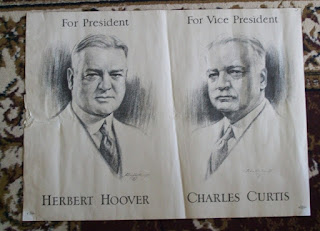Calvin Coolidge and the Republican party had controlled the 1920's, and for the party, the election of 1928 would be no different. Determined not to run again, the Republicans nominated Commerce Secretary Herbert Hoover to run for the high office, and Kansas senator Charles Curtis was chosen as the vice president. As for the Democrats, continued prosperity did not bode well for them, and New York governor Al Smith was chosen to run for president on the first ballot, while Senator Joe Robinson of Arkansas was chosen as the vice presidential nominee. The campaign largely focused on Al Smith's religious affiliation: Catholic. Many Americans feared Smith would take orders from Rome on policy, and Hoover and the Republicans spread fear and anti-Catholicism swept the nation. Protestants came out in full force to stop Smith, and it worked, as Hoover won nearly 58% of the popular vote and won an electoral college landslide 444-87, even winning Smith's home state of New York. Hoover was popular after his relief efforts during World War I and not being involved in the scandals the plagued Harding's administration. As Hoover took office, prosperity continued and America grew, but by the fall of 1929, things started turning for the worse, and in October, the stock market crashed. With millions of Americans losing everything they owned in what became know as the Great Depression, Hoover was seen as the reason for the downfall. For most of Hoover's term, the Depression was the focus of his administration. Hoover largely felt the economy would rebound without heavy government interference, and was reluctant to introduce programs giving handouts to citizens, an opposite belief than Franklin D. Roosevelt would try a few years later. Hoover did stop reparation payments left over from WWI, but this did little to help. Also, Hoover believed that giving money to the citizens would decrease the amount of citizens who sought jobs, and this would prove to be the case in the decades to follow. By 1932, Hoover had decided to raise taxes on the wealthiest Americans, and also raised the corporate tax rate. Some of these policies helped, but it was viewed as too little too late by many. One last stain on the Hoover administration was when the "Bonus Army" marched on Washington, demanding payment of WWI bonuses. When Hoover refused to meet with them, Douglas MacArthur was sent out to meet the crowd, and a brawl ensued between the Army and the citizens and many were wounded, hurting Hoover's public image. Many poor people began to associate Hoover with the Depression, naming towns "Hoovervilles" and so forth. By the time of the 1932 election, Americans wanted change in the White House. As for campaign items from the 1928 election, buttons are rather scarce, except a few single picture ones and word pins. Any jugate button of Hoover and Curtis or Smith and Robinson are hard to find and often very pricey. Many paper items like posters and sheet music are more common and won't cost your arm and leg, just one of your limbs. I have included some of my paper items in this blog, like a Hoover/Curtis poster, Smith/Robinson poster, a piece of Smith sheet music, a Smith silk handkerchief, a Hoover home sign, and an ad saying Hoover will win the election based on a straw poll. As for buttons, I have included a Smith button with a Derby hat attached, something he was famous for wearing. I did not include a Hoover pin, but I do own a couple common word pins. This campaign also produced some anti-Catholic items supporting Hoover, such as a button saying "A Christian in the White House" and so forth.







No comments:
Post a Comment